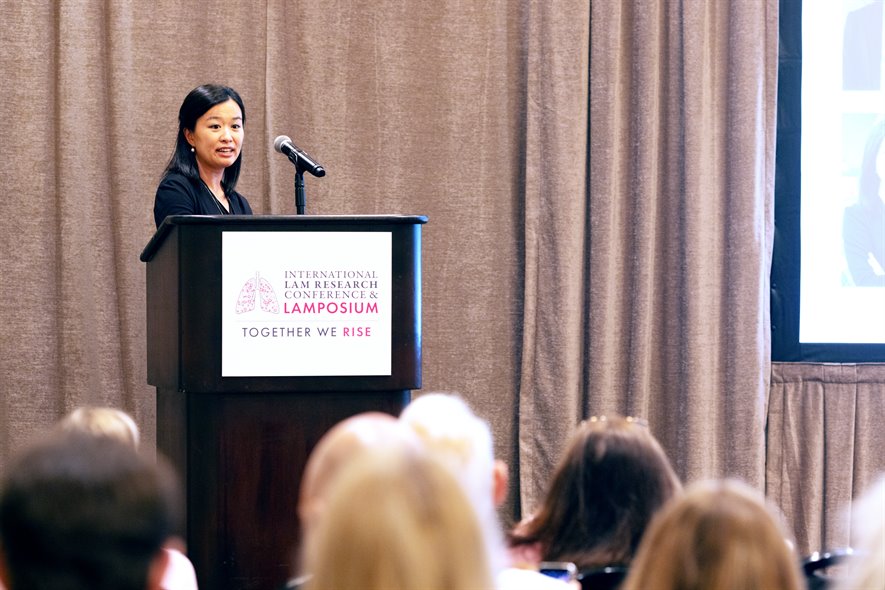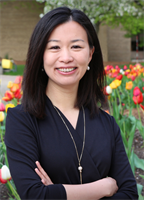A Conversation with Bonnie Wang, MD

Dr. Bonnie Wang is a clinical assistant professor in internal medicine and pulmonary and critical care at the University of Michigan. Her clinical and research areas of interest include interstitial lung disease and LAM. She currently serves as a co-director of the LAM clinic at the University of Michigan.
Dr. Wang served on the steering committee at The LAM Foundation’s most recent LAMposium, part of the 2022 International LAM Research Conference & LAMposium. There, she presented a session on interpreting LAM test results and moderated a patient panel about living with LAM.
This interview is edited for length and clarity.
 The LAM Foundation: What were your takeaways as a clinic director, from LAMposium, especially for people reading this or who may not have been there?
The LAM Foundation: What were your takeaways as a clinic director, from LAMposium, especially for people reading this or who may not have been there?
BW: I was amazed and just in awe about the whole setup in general of the conference. I really loved how it was a space and time for patients, clinicians, and researchers to all be in one place at the same time. Because I’m a clinician by nature, all of my interesting questions come from patients, actually. We hear from patients directly in a forum where we are trying to design research experiments to find pathways, or to help answer those questions directly. We hear about their experiences, we hear about their challenges, and we try to figure out ways to make their lives better. It is one of the most unique things about The LAM Foundation. You don’t really have conferences where patients attend with clinicians and scientists.
The LAM Foundation: Do you feel that attending LAMposium enhanced your work as a clinician?
BW: For me, a large part of the symposium was meeting the other clinic directors, putting faces to names, and having a community of other clinicians taking care of patients with LAM so that when I have questions in the future, I’m not emailing or calling like a stranger. It was also really nice to meet very grateful people. People I had never met came up to me and said, ‘thank you so much for giving that talk.’ Even if I’m not a researcher who’s making a breakthrough discovery — just by seeing patients in the clinic, providing reassurance, listening to them, trying my best to answer questions, or sending their questions out to a bigger community, that was meaningful.
The LAM Foundation: At LAMposium, you also participated in the Rose Ceremony, a real tradition at The LAM Foundation.
BW: I’ve never participated in anything like it before. I thought it was very touching, a really nice event where each person is recognized individually. A rose was a nice symbol, but I thought it was really nice to recognize individuals. Each person has contributed to this community, whether it be by being brave enough to share their journey or brave enough to ask questions, brave and open.
The LAM Foundation: Talk about when you first began working with LAM patients.
BW: I started seeing patients with LAM about two years ago. It was amazing to see how much knowledge, research, and advancement had been done in this condition over the last 20 years or so. Although we still had a lot of unanswered questions — normal questions that people would ask in the clinic. When I didn’t know the answer, I would reach out to my senior mentor at Michigan, and she connected me with Nishant Gupta (Scientific Director of The LAM Foundation). It was a way that I could help patients who had a rare disease who may not be able to get help elsewhere.
The LAM Foundation: You mentioned how much progress there’s been made in LAM over the last 20 years – not long after The LAM Foundation was created. Is there a connection there?
BW: 100 percent! It was all the Foundation. The LAM Foundation has done amazing work – again, just by the number of volunteers I saw at the conference, by helping us fund research, and by putting together our clinic director calls so we can learn from each other. We would definitely not be where we are without The LAM Foundation. And I do personally thank every single person involved.
The LAM Foundation: As a clinician, you understand the synergy between clinicians and patients and how you learn from each other.
BW: I’ve always learned more from patients based on what we talk about in the clinic and the questions that come up. That really inspires me to either talk to other clinicians or do a deeper dive into reading the literature about a certain thing. That’s always been kind of near and dear to my heart. It always starts with the patient. Maybe it’s just the way I was brought up in training, but that is where my inspiration and the source of motivation for my work is — how is this going to help the person in front of me?